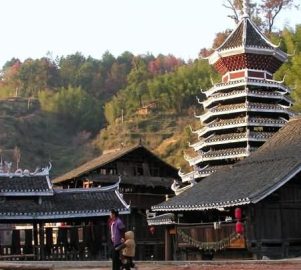History of Dong Ethnic

At the time of the Qin and Han dynasties (221 B.C.-A.D. 220) there lived many tribes in what is present-day Guangdong and Guangxi.
The Dong people, descendants of one of these tribes, lived in a slave society at that time. Slavery gradually gave way to a feudal society in the Tang Dynasty (618-907).
Agriculture developed rapidly during the Qing Dynasty (1644-1911) in the Dong areas in southeast Guizhou and southwest Hunan provinces. Rice production went up with improved irrigation facilities. And self-employed artisans made their appearance in Dong towns.
Markets came into existence in some bigger towns or county seats, and many big feudal landowners also began to do business. After the Opium War of 1840-42, the Dong people were further impoverished due to exploitation by imperialists, Qing officials, landlords and usurers.
The Dongs, who had all along fought against their oppressors, started to struggle more actively for their own emancipation after the founding of the Chinese Communist Party in 1921. They served as guides and supplied grain to the Chinese Red Army when it marched through the area during its Long March in the mid-1930s. In 1949, guerilla units organized by the Dong, Miao, Han, Zhuang and Yao nationalities fought shoulder to shoulder with regular People's Liberation Army forces to liberate the county seat of Longsheng.
Religion of Dong Ethnic
In everyday life, there exists among the Dong, animistic religious beliefs and practices; benevolent and malevolent spirits exist everywhere in nature. Valley's, rivers, mountains, trees and rocks, the netherworld, bridges and wells, all have spiritual significance and attending spirits that must be acknowledged and taken care of in the proper way, so as to not destroy an existing balance.
In some parts of the mountains, the land cannot be dug; some trees are not to be cut; there are stones that cannot be cracked. If people trespass against beliefs, it is believed disaster is syre to follow.
Must-see Villages in Guizhou and Guangxi
Basha Zhaoxing Tang'An Xijiang Sanjiang Longsheng
Frequently asked questions in Guizhou





